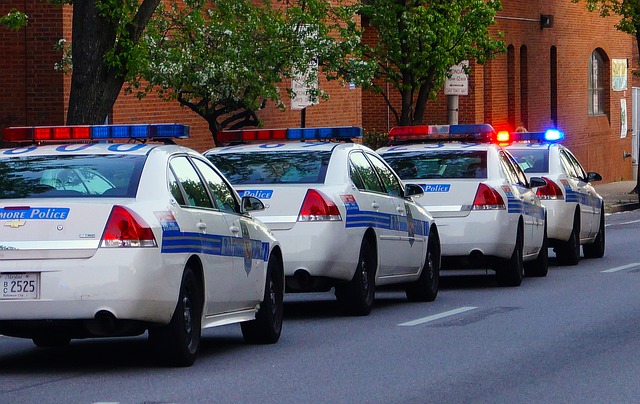 The Baltimore Police Department is warning motorists of the rising threat of armed carjackings presently occurring throughout the city. These incidents have taken place in record numbers in areas such as Homewood near John’s Hopkins and in the Brooklyn and Cherry Hill areas of south Baltimore. Most of the cases appear to be carried out by two or more individuals who initiate a minor fender bender on city streets. As the unsuspecting driver exits his or her car, one of the individuals from the accident-initiating car exits and confronts the driver. Many times the co-conspirators have used physical force to neutralize the driver before stealing his or her vehicle. Other times the robbers have used the threat of force such as brandishing a weapon to prevent the driver from resisting. Either way these incidents have caught the eye of city police officers, and have prompted the department to issue media warnings to motorists.
The Baltimore Police Department is warning motorists of the rising threat of armed carjackings presently occurring throughout the city. These incidents have taken place in record numbers in areas such as Homewood near John’s Hopkins and in the Brooklyn and Cherry Hill areas of south Baltimore. Most of the cases appear to be carried out by two or more individuals who initiate a minor fender bender on city streets. As the unsuspecting driver exits his or her car, one of the individuals from the accident-initiating car exits and confronts the driver. Many times the co-conspirators have used physical force to neutralize the driver before stealing his or her vehicle. Other times the robbers have used the threat of force such as brandishing a weapon to prevent the driver from resisting. Either way these incidents have caught the eye of city police officers, and have prompted the department to issue media warnings to motorists.
Police spokesmen have advised anyone involved in a minor traffic accident to stay in their vehicle with the doors locks and to call 911 immediately. The main message from police is that personal safety is far more important than properly exchanging insurance information for a claim. If handled correctly the thieves likely will either abort their criminal plan or flee the scene. Through the first four months of 2016 city law enforcement has documented 110 carjacking robberies compared to 75 during the first four months of last year. Standard automobile thefts are also up almost 20 percent so far this year, with 1,359 being reported as of April 30. The use of any type of physical force during the act of stealing a car will trigger charges for carjacking, which is a serious violent felony that carries a 30-year maximum jail sentence under section 3-405 of the Maryland Code. If a firearm is used the defendant faces an additional mandatory 5-year sentence. Just as in any robbery case, even the threat of force is enough to trigger a felony charge over a standard theft charge. This is true regardless of whether the culprit has the ability to actually carry out the threat, as all that matters is whether the victim reasonably believed the robber could follow through.
Advancements in anti theft technology in most new cars have resulted in a steady trend of decreasing automobile theft cases. In 2003 there were over 8,000 incidents, but in the last few years this number has been between 4,000 and 5,000. It appears that this year the number of car thefts will break 5,000 though, so hopefully this does not signal a shift in the recent trend. Motor vehicle theft falls under 7-105 of the Maryland Code, and is a felony with a 5-year maximum penalty.
 Criminal Defense Lawyer Blog
Criminal Defense Lawyer Blog








 News trucks and National Guard Humvees are no longer lining the streets of Baltimore, but the city is still experiencing elevated crime levels and widespread violence following riots that generated worldwide attention. Forty-two people were murdered within city limits last month, the highest monthly total in over 40 years, and millions of dollars worth of narcotics have fallen into the hands of drug dealers in the last few weeks. The murder rate is attributed by some as a direct result of a lower police presence in high crime areas, exactly the opposite of what is needed. Police in the tensest areas such as the western district of Baltimore City have allegedly shifted their priority to self-preservation rather than protecting the public. According to an anonymous supervising officer who was interviewed on CNN, cops in the western district are basically ignoring orders from the police leadership to vigorously patrol, and are just simply responding to 911 calls. This passive approach is likely causing a sense of lawlessness in certain areas, and in turn wrongdoers are becoming bolder. Although the police commissioner has no plans to step down, there is growing discontent about the department’s leadership going forward. One city councilman has publically called for a new police commissioner, stating that he knows rank and file officers have lost confidence and respect for their commander. This environment has officer moral and motivation at an all time low, and city residents are suffering the consequences.
News trucks and National Guard Humvees are no longer lining the streets of Baltimore, but the city is still experiencing elevated crime levels and widespread violence following riots that generated worldwide attention. Forty-two people were murdered within city limits last month, the highest monthly total in over 40 years, and millions of dollars worth of narcotics have fallen into the hands of drug dealers in the last few weeks. The murder rate is attributed by some as a direct result of a lower police presence in high crime areas, exactly the opposite of what is needed. Police in the tensest areas such as the western district of Baltimore City have allegedly shifted their priority to self-preservation rather than protecting the public. According to an anonymous supervising officer who was interviewed on CNN, cops in the western district are basically ignoring orders from the police leadership to vigorously patrol, and are just simply responding to 911 calls. This passive approach is likely causing a sense of lawlessness in certain areas, and in turn wrongdoers are becoming bolder. Although the police commissioner has no plans to step down, there is growing discontent about the department’s leadership going forward. One city councilman has publically called for a new police commissioner, stating that he knows rank and file officers have lost confidence and respect for their commander. This environment has officer moral and motivation at an all time low, and city residents are suffering the consequences.